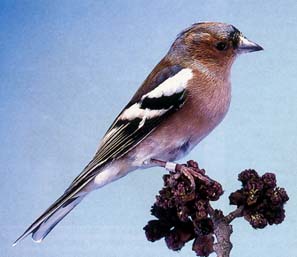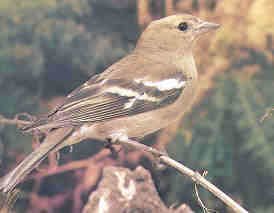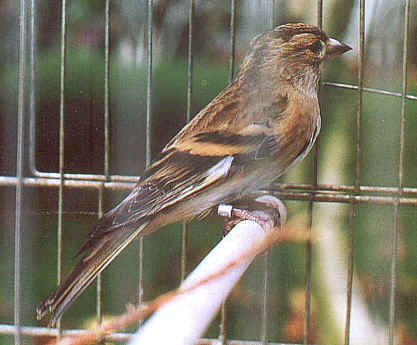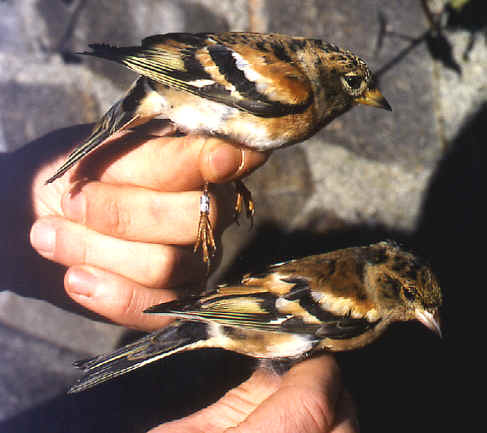
CHAFFINCH CROSSES
At this time the Chaffinch cock has only ever crossed with the Bramblfinch
Treat as softbills during breeding season the eggs hatch approx. 13 days after sitting occurs, young leave the nest at 14 days old and are self supporting at 28 days

COCK
COLOUR VARIANT CHAFFINCHES CLICK HERE
HEN
BREEDING PAGES CLICK HERE
Status and distribution Widespread and generally abundant from the British Is, western France and Iberia east to the Urals and north to beyond the Arctic Circle in Scandinavia and south to the Canary Is, North-West Africa and north Libya, the Mediterranean Is, Turkey and the Caucasus and the Middle East.
Most Swedish and Finnish birds are migratory as are those from eastern Poland eastwards. In winter becomes more widespread around the Mediterranean and in the Middle East.
Vagrants have been recorded in Iceland.
Subspecies Many races have been recognised in the Region, differing mainly in plumage of male. Most European birds are very similar with nominate coelebs occurring over much of Europe, gengleri in the British Isles with more brick-red underparts and schiebeli from Crete, paler below with pale pink throat.
North African and Atlantic Is birds are more distinct, africana from Morocco to western Tunisia and also Cyrenaica is blue-grey on head and nape, olive-green on back and rump and pale pink below, spodiogenys from eastern Tunisia and NW Libya is similar but has blue rump and more white in wings. Canarian tintillon from Gran Canaria, Tenerife and Gomera has very dark blue upperparts, green rump and pale orange underparts, ombriosa from Hierro is similar but greener on back and paler below and palmae from La Palma are all blue above and whitish below. Madeiran race maderensis is blue on head, nape and lower back, greenish on mantle and rump with pale orange throat and breast and whitish belly and flanks. Azorean moreletti is similar but paler blue above, blue rump and more extensive orange below.
Habitat Coniferous, mixed and deciduous woodland, farmland with hedgerows and copses, parks and large gardens. Atlantic Is birds mainly in laurel and pine forests
Whether bred using the Bramblefinch cock or the Chaffinch cock, the cross is almost identical and it is only the smaller amounts of white on the wing bars and the slightly smaller head of the Bramblefinch that give some clue to the male parentage, but even these distinctions are not infallible and one needs great experience to even hazard a guess let alone a definite answer as to which way round this cross was produced
Thanks for the Photo: Lubomir Vesely (Czeck Republic)

CHAFFINCH FEEDING TECHNIQUES
SEED: good British finch mix including a small amount of hemp, pine nuts, sunflower, groats, niger, maw, gold of pleasure and perilla, also a good multi vitamin with added probiotic.
REARING: soaked seed, egg food, a supply of green food and small amounts of live food, unlimited when rearing young, fresh water daily and mineralised grit with a small amount of charcoal added.
